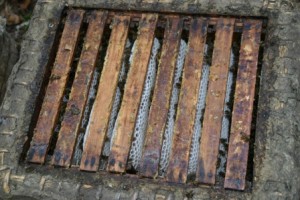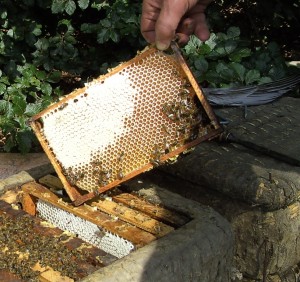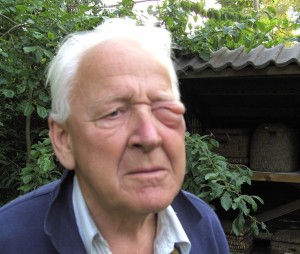Selection goals at the “de goederaat” differ from goals of selection in most breeding programs.
1 Longliving bees. The first time a rode the books of brother Adam, I could not believe that black bees were bees that live longer than bees of any other race. I thougt that they only lived longer because they were not as hard working as other bees, but that is certainly not true. It is hardly beleaveble but in the last years I had successess with very small colonies that I cannot explain other than because of their hardyness and longliving.
So, this is a valual treat, worth to be kept. But I don’t know how to select on longliving bees. But it seems obviously, that long living bees has also long living queens. So, in my apiary, queens are allowed to live longer than the economical 2 years. That does not automatically mean that all queens are allowed to live very long. My worker bees has something to say too and they don’t ask me, when they start to replace an old queen.
2 No drifting of bees.
German investigation has shown that carnolian bees drift 4 times more, and buckfast bees even 5 times more, than black bees. With drift I mean that those bees go into the wrong colonie.
This means that the spread of diseases and the reinfection with varroamites after a treatment, happens 4 til 5 times faster in carnolian and buckfastbees.
So this caracteristic of the black bee is worth to be safed. But how can I select on less drifting or even better, not drifting. Not by having more space between the colonies, that only does diminuishing drift but deteriorates a selection on that point.
Selection happens in the mating period of the young queens. The queenmating nuclei are standing close together and the queens have to be marked for their mating flights, so by inspecting them you will find out which queens are in the wrong coloni. This selections costs very much, because the mating ratio will be very low, and many queens will be lost. It is also an unnatural way of selecting, because in nature, between colonies there is often half a mile. Than, even the most drunken bee, will not drift into the wrong coloni.
3 My bees have to be able to overwinter on heatherhoney of the calluna vulgaris. Even when this kind of honey is the most important product in my apiary that will be sold totally, it is necessary that my bees are able to overwinter on this honey. This honey should be disadvantagious for the bees, by a high amount of non digestable stuff. Than the bees have to go to the toilet, but they don’t like the cold winterdays and will then just drop their excrements on the combs and so diseases are spread in the colony.
Yet my bees, are obliged to survive on heatherhoney. If they are not able to prepare the honey in the right way, they will not survive. So my stock exist only of bees that is able to overwinter on heatherhoney. That means that they handle incoming nectar better and produce better honey. That is also what I need for my customers.


4 White cappings of heathercombhoney.
This is not only commercially interesting because it looks better, but it also means that there is some air under the cappings, that improves the storage of this combhoney. Some yellow cappings are not a big problem. This mostly means that nectarflow has been some time less abundant. Dark cappings and cappings against the honey (wetcappings)are not allowed. Colonies with that behaviour will be excluded from the selection.
5 The right swarming behaviour
Believe it or not, but in the last years I have seen many prime swarms that came after an afterswarm, or colonies that swarms in 8 days two times, but by inspection it turns out that the old Mom is still laying eggs, so only her doughters swarmed. This behaviour, that is, at least in the extension as it exist now, unbiological. It proves that even my stock is partly infected by the treats of commercial beeraces, that are selected on low swarming tendency.
But this treat is not only unbiological, but it is in my apiary very uneconomic. So colonies with this behaviour are excluded from selection.

6 The right stinging behaviour or normal defensive behaviour
Some apiarist are proud of their gentle bees, with those they will go into bed. But those bees are so gentle that they don’t protect the entrance of the coloni, so that bad bees will rob them and spread their diseases. The bees are sometimes so gentle that they refuse to kill a mouse that comes into the colony and ruine the combs.
I don’t want that kind of bees. I want bees that defend themselves. On the other hand, I don’t want bees that attacks pedestrians on the road 40 metres from their skeps. So what I want are bees that have the right defensif behaviour, that is not the same as agressif. Their stinging has to have a good reason.